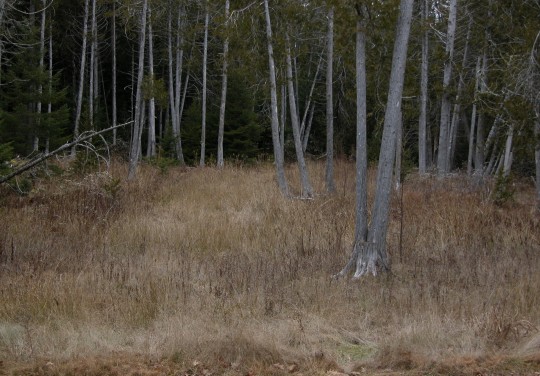Quoddy Nature Notes – Cedar

This used to be a pretty dense cedar grove. As the trees died or blew over I carefully took them out, and tried not to disturb the remaining trees, but all it did was turn into a damp, grassy meadow. On this acre + area there is only one cedar seedling started. Next year I will put in some live cedar twigs and see if they germinate.
Maine has three kinds of cedar trees that are native: the Northern White cedar Thuja occidentalis, the Atlantic White cedar Chamaecyparis thyoides, and the Red cedar Juniperus virginiana. One of the many interesting things about our cedars is that they are not cedars at all, and are not closely related to the old world cedars like the famed biblical cedars of Lebanon, but belong to the cypress family. I like the name ‘cedar’ better than ‘cypress’ and since they’re ours I guess we can call them anything that we want. Here in the Quoddy region the only native cedar we have is the Northern White cedar (Kakskus in my Passamaquoddy/ Maliseet reference book), although a lot of different types and subspecies and variations have been brought in as ornamentals. The original range of our cedar was from New Brunswick through New England and New York along the Canadian border out to around Minnesota, as far north as the Hudson Bay and scattered populations as far south as Tennessee. Nova Scotia and Newfoundland, according to the maps, have little Northern White cedar.
Our cedar is a light, rot resistant wood that, although it is not strong, is good for fence posts, log cabins, canoes and even fragrant wreaths. Some sawmills specialize in processing cedar, but the trees usually don’t grow very big or very fast, although they may live a long time. Apparently the oldest living tree east of the Rockies is a puny Northern White cedar over 1500 years old growing slowly out of a cliff face in Ontario. It is strange that our cedar chooses either alkaline swamps or rocky outcroppings as places to grow. I have examples of both environments here in Pembroke and I am still puzzled. Some real, honest-to-goodness botanists have also been perplexed by this mystery and have even proposed two ‘genetic races’ as a solution. When cedar grows in swamps it forms pretty dense groves. Now forestry books say that when a tree in a dense grove falls or dies this action lets in sunlight and new trees quickly sprout up. Not so with cedar. I have several instances confirming this puzzle. Apparently one can easily propagate cedar by sticking live twigs in the ground. I have not tried this but will in my grassy former cedar groves. If this does work the wretched deer and rabbits may chew them off first, and the porcupines will gnaw on them if they get big. Moose apparently won’t eat cedar unless there is nothing else around. Red squirrels use the bark almost exclusively to make nests.
It is in the medicinal field that our cedar really shines. Jacques Cartier brought back cedar to France, and, since this was associated with his curing his men of scurvy, it was called Arbor vitae, or ‘tree of life’. This may or may not be the plant that saved Cartier’s men, and it could have been something else, because Cartier records the medicinal miracle as ‘annedda’. When Champlain was here in 1604 apparently he failed to communicate with the Native Americans about his desire for ‘Annedda’ , and his men suffered greatly. The shame was that, although cedar was probably the best choice as a solution for scurvy, other trees like spruce, hemlock or white pine and berries like cranberries and lingonberries would have sufficed. The local natives ate all of these regularly, and probably were not familiar with the curse of scurvy. In fact scurvy was a continuing problem with woodsmen until relatively recent times. A little ditty that arose among the 19th century lumbermen who normally ate beans, bread, salt pork and anything that they could shoot, was: ‘A pint a day of Arbor Vitae, keeps a man strong and mighty’.
The name ‘Arbor Vitae’ is also interesting. In anatomy this is the cerebellar white matter part of the brain that is branched something like a tree or fern; in geography Arbor Vitae is a town in Wisconsin, pop.3153; and in social work Arbor Vitae is a center in Michigan that supports women who are facing unexpected pregnancies. This last association is very ironic. Even if a tea made out of Arbor Vitae does cure scurvy, it can be dangerous for pregnancies, and caution is advised.
I’ve made tea out of the bark and leaves of Arbor Vitae, and straight it tasted like a 2X4 from EBS. It’s palatable if you add a goodly amount of honey. I noticed at Walgreens that I can buy some medication for warts made from Arbor Vitae. That will probably work as well as the stump water I used for warts when I was a kid.




